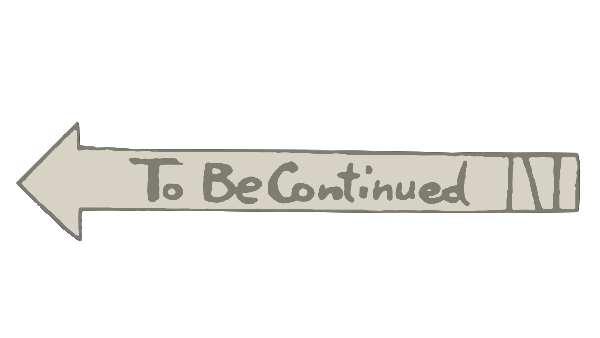运行在终端的应用
tui,全称为 Terminal UI,意为在终端上绘制图形,结合应用程序即可得到运行在终端的应用程序。
流行 TUI 框架一览
陆续尝试过一些 tui 框架,这里简单介绍各框架优劣,以及我的使用体验。
blessed
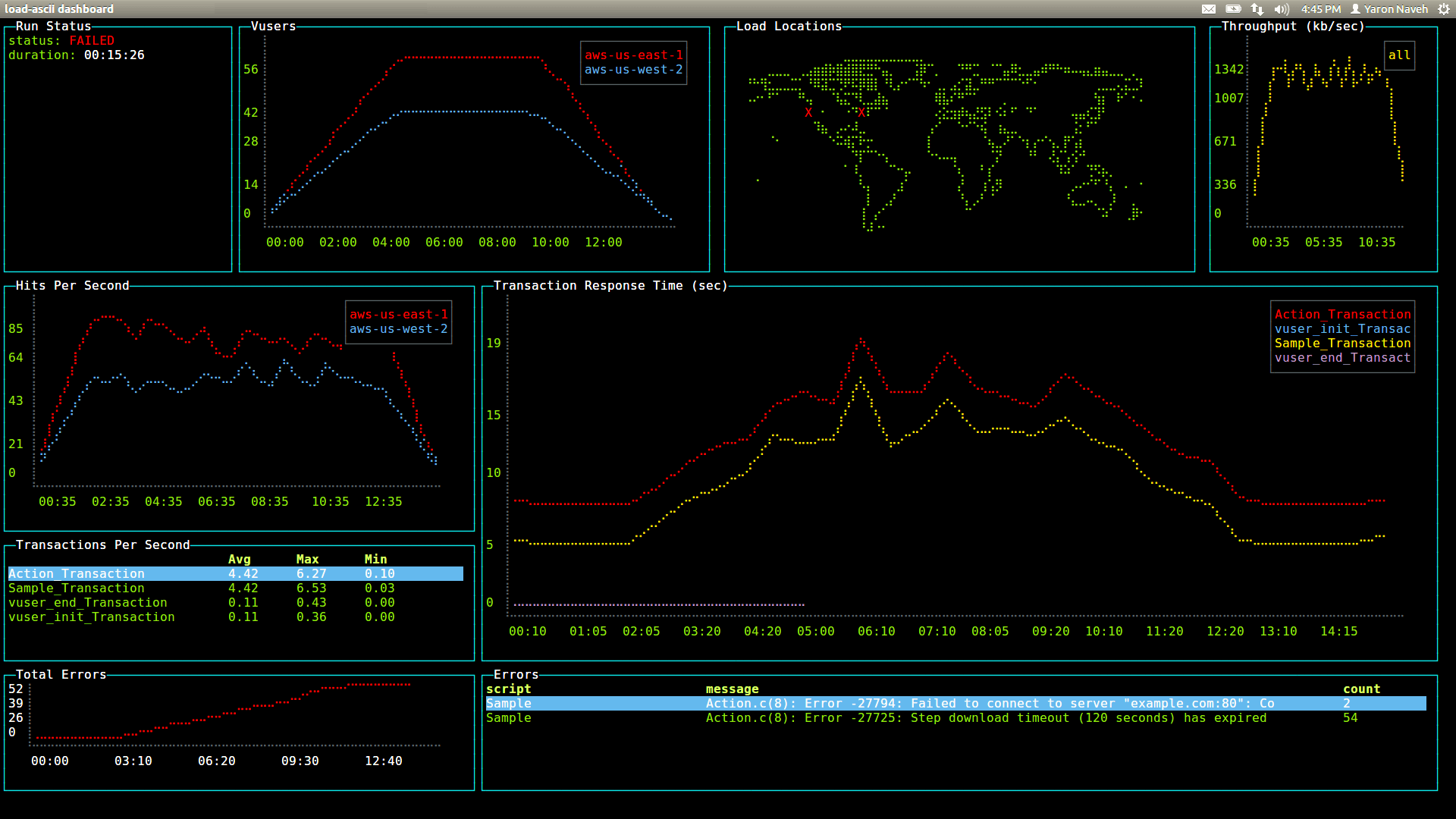
评分:★★★☆☆
blessed 是一个基于 nodejs 的终端界面库,提供了高级的终端接口,使在终端上实现可交互的界面。
基于 nodejs 使之面向前端友好,提供了丰富的组件以及大量的 api,让构建应用得心应手。
- 优点:功能极其强大,一个库就似乎可以完成所有的事情。基于 nodejs,面向前端友好。
- 缺点:优点即缺点,功能太多配置太多,使用起来太复杂。基于 nodejs 也意味着难以原生跨平台。最最重要的,这个库已经近 10 年没更新了 😂😂
来都来了,看看这个基于 blessed 的控制台游戏集合:togame
tview
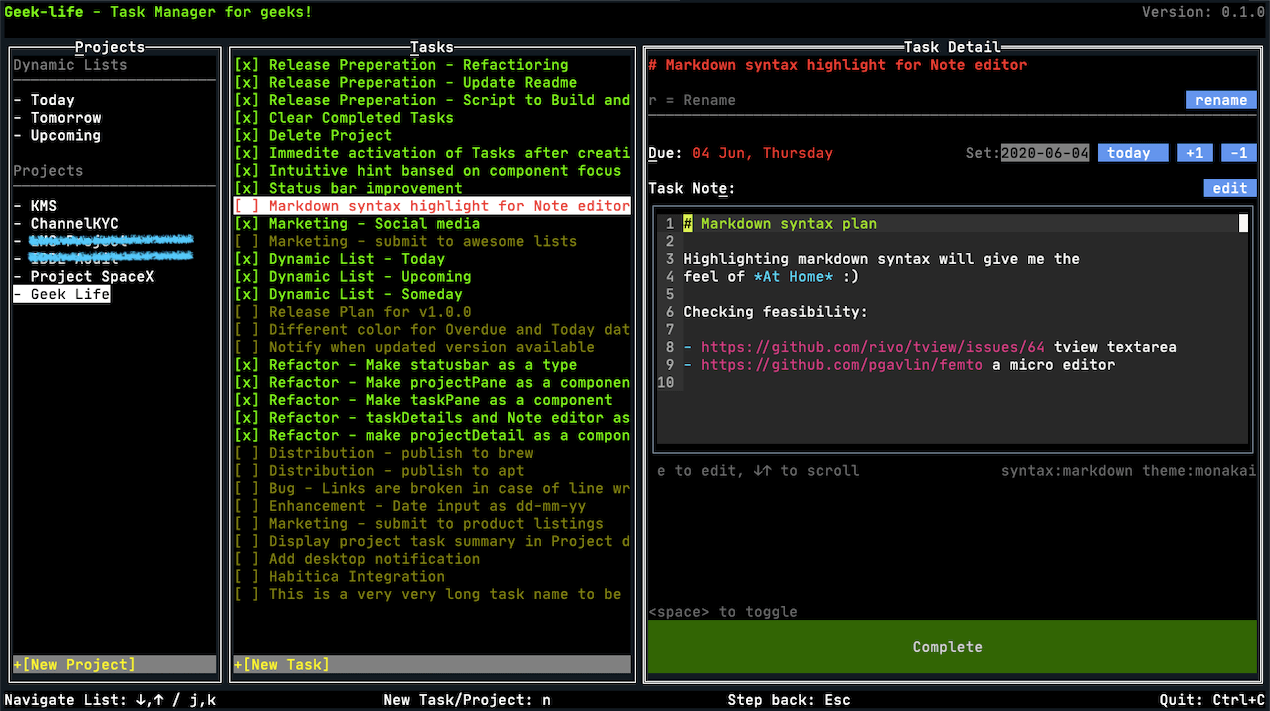
评分:★★★☆☆
tview 是一款基于 golang 的终端应用框架,提供了一系列常用基础组件,包含了 表单、文本域、表格、弹性布局、Grid 布局、模态框等。
也拥有一定的社区生态,可以找到好用的第三方组件,使用基数也相当的高。
- 优点:类面向对象,组件化程度相当高,对于管理类应用可以快速集成,上手成本较低。
- 缺点:扩展现有组件、新增组件,成本较高,需要对于 tui 应用和现有项目有一定的了解。UI 只适合管理类的应用,比较保守/老旧。
写过一个基于 tview 的记事本程序:https://github.com/shalldie/tnote/tree/ver.tview
bubbletea
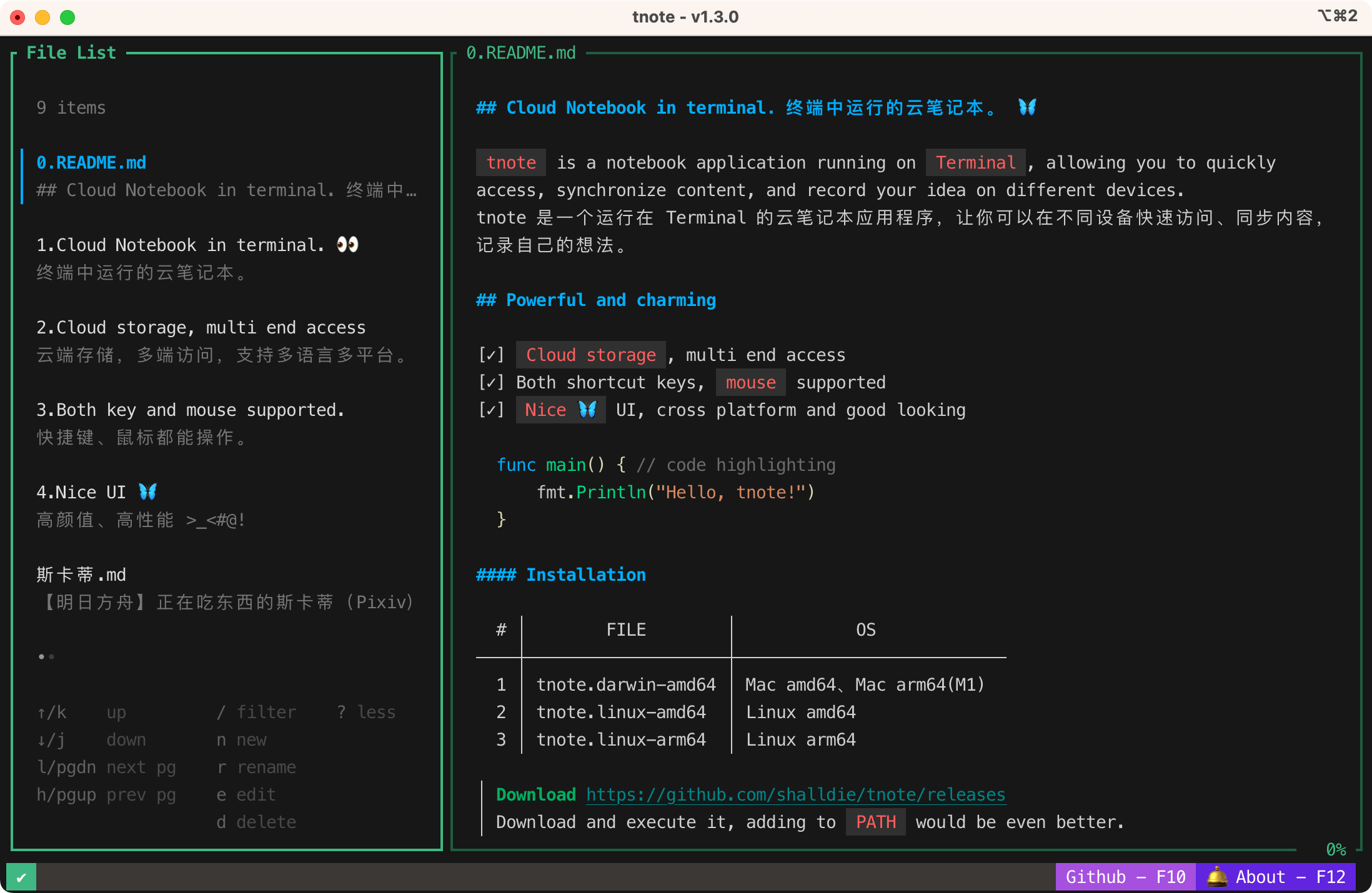
评分:★★★★☆
bubbletea 同样基于 golang,非常适合构建复杂交互的终端应用程序,同时还能让命令行程序变得多彩和炫酷。
它是 charmbracelet 家族的一部分,下面分享下我对于这些库的理解和使用。
- 优点:高度灵活,组件化程度高,生态丰富,好看。
- 缺点:上手需要一定的成本。
bubbletea
bubbletea 是一个强大的 TUI 框架,简单、小巧,内置简单的事件处理机制,可以对外部事件做出响应,比如键盘按键,鼠标点击等。
准备&简介
在开始前先引入该库,一般用 tea 做别名,毕竟 bubbletea 有点长:
1package main
2
3import (
4 "fmt"
5 "os"
6
7 tea "github.com/charmbracelet/bubbletea"
8)bubbletea 应用/组件,由一个描述应用程序状态的 model,和 model 上 3 个简单方法组成:
Init, 在应用/组件创建的时候会调用,做一些初始化工作,返回一个cmd来告知框架要执行什么命令。Update, 用于响应外部传入的事件,并据此来更新 model,进而触发 ui 更新.View, 根据 model 来生成需要在控制台显示的字符串,没错,它的视图全都是字符串比较底层。
关于 model
model 一般用来存储应用的状态,可以是任何类型,但是大部分情况一般会用 struct 来做,更面向对象。
1type model struct {
2 choices []string // items on the to-do list
3 cursor int // which to-do list item our cursor is pointing at
4 selected map[int]struct{} // which to-do items are selected
5}Init
在 golang 中,struct 的初始化一般都会用工厂,即一个函数去返回 struct 的实例。
1func initialModel() model {
2 return model{
3 // Our to-do list is a grocery list
4 choices: []string{"Buy carrots", "Buy celery", "Buy kohlrabi"},
5
6 // A map which indicates which choices are selected. We're using
7 // the map like a mathematical set. The keys refer to the indexes
8 // of the `choices` slice, above.
9 selected: make(map[int]struct{}),
10 }
11}需要给 model 定义 Init 方法,它返回 Cmd 来告知程序需要做什么工作。如果什么都不需要刻意返回 nil,表示 no command。
1func (m model) Init() tea.Cmd {
2 // Just return `nil`, which means "no I/O right now, please."
3 return nil
4}Update
when things happen,当事件发生时,Update 方法会被调用,它会判断发生了啥,并返回新的模型来作为响应,也可以返回 Cmd 来使更多的事件发生。
比如用户按下了某个按键,点击了某部分,鼠标滚轮,或者是自定义的事件。
事件触发 以 Msg 的形式出现,它可以是任何类型。Msg 是发生的某些 I/O 的结果,例如按键,来自服务端的响应等。
我的经验,用类型来表示事件类型,该类型的值作为事件负荷的载体。类似于 Payload。
1func (m model) Update(msg tea.Msg) (tea.Model, tea.Cmd) {
2 switch msg := msg.(type) {
3
4 // Is it a key press?
5 case tea.KeyMsg:
6
7 // Cool, what was the actual key pressed?
8 switch msg.String() {
9
10 // These keys should exit the program.
11 case "ctrl+c", "q":
12 return m, tea.Quit
13
14 // The "up" and "k" keys move the cursor up
15 case "up", "k":
16 if m.cursor > 0 {
17 m.cursor--
18 }
19
20 // The "down" and "j" keys move the cursor down
21 case "down", "j":
22 if m.cursor < len(m.choices)-1 {
23 m.cursor++
24 }
25
26 // The "enter" key and the spacebar (a literal space) toggle
27 // the selected state for the item that the cursor is pointing at.
28 case "enter", " ":
29 _, ok := m.selected[m.cursor]
30 if ok {
31 delete(m.selected, m.cursor)
32 } else {
33 m.selected[m.cursor] = struct{}{}
34 }
35 }
36 }
37
38 // Return the updated model to the Bubble Tea runtime for processing.
39 // Note that we're not returning a command.
40 return m, nil
41}这里的例子,当按下了 ctrl+c 或者 q 的时候,会返回 tea.Quit 命令和 model。这是一个特殊命令,会告知 Bubble Tea 去退出应用程序。
View
所有的方法中,View 是最简单的。就是根据当前 model 的状态,返回一个字符串。字符串就是最终的 UI。
因为视图描述了应用程序的整个 UI,所以不必担心重新绘制逻辑之类的事情。Bubble Tea 会帮你搞定的。
身为前端对状态管理也经常用到,我也有一些不成熟的经验。应用的各个部分状态如果分散到各个组件中去,很难去互相访问到。如果集中管理状态,集中处理业务,就把 业务层 和 UI层 分离了,能更好的组织业务逻辑,组件就只负责渲染就行。做法是弄一个单例去存储所有的状态,还是用 Update 去通知更新,不过 View 中会引用这个单例中的值去更新。
1func (m model) View() string {
2 // The header
3 s := "What should we buy at the market?\n\n"
4
5 // Iterate over our choices
6 for i, choice := range m.choices {
7
8 // Is the cursor pointing at this choice?
9 cursor := " " // no cursor
10 if m.cursor == i {
11 cursor = ">" // cursor!
12 }
13
14 // Is this choice selected?
15 checked := " " // not selected
16 if _, ok := m.selected[i]; ok {
17 checked = "x" // selected!
18 }
19
20 // Render the row
21 s += fmt.Sprintf("%s [%s] %s\n", cursor, checked, choice)
22 }
23
24 // The footer
25 s += "\nPress q to quit.\n"
26
27 // Send the UI for rendering
28 return s
29}启动应用
把入口的 model 传递给 tea.NewProgram,就能开启一个新的应用。该 model 通常是作为一个 layout 来布局,同样的各个组件也能继续嵌套其它组件,最终形成一个树状结构,入口的 model,即为根结点。
1func main() {
2 p := tea.NewProgram(initialModel())
3 if _, err := p.Run(); err != nil {
4 fmt.Printf("Alas, there's been an error: %v", err)
5 os.Exit(1)
6 }
7}相关生态
这是我倾心于 bubbletea 的一个重大原因,它拥有很多相关联的库(自己的,第三方的),Issues 和 Discussions 都挺活跃,反馈及时。
Bubbles
Bubbles: 常用的 Bubble Tea 组件,比如 text inputs、viewports、spinners 等等。
Lip Gloss
Lip Gloss: TUI 的样式、格式、布局相关的工具库,非常强大!! 且好看:
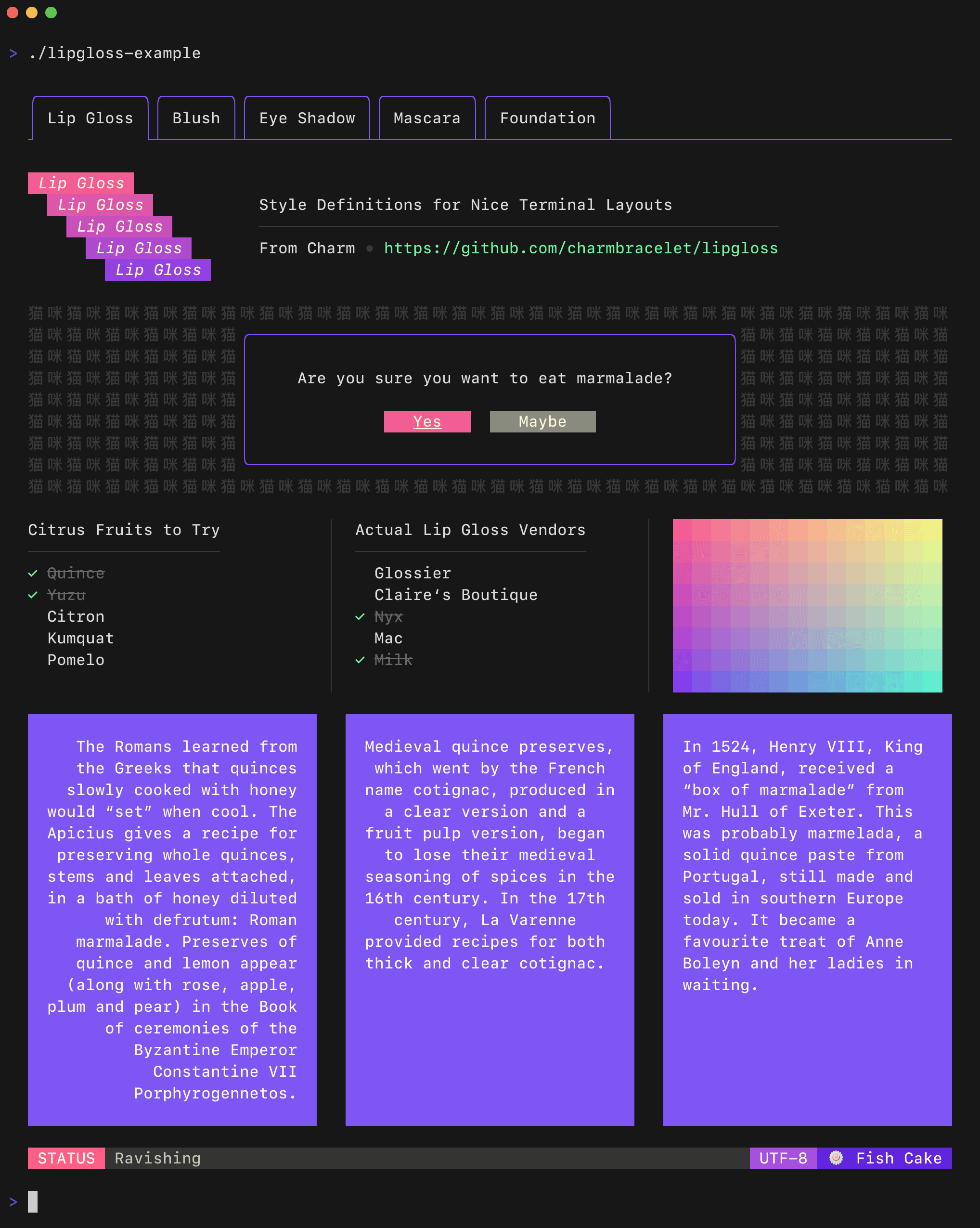
Harmonica
Harmonica: 一个动画库,能给 tui 添加流程、自然的运动效果。
BubbleZone
BubbleZone: 可以给 Bubble Tea 组件便捷的添加鼠标处理事件。
Glamour
Glamour: Markdown 渲染器,可以在 CLI 应用上渲染出好看的 markdown 内容。
TNote
基于 Bubble Tea,我写了个运行在 Terminal 的云笔记本应用程序,可以在不同设备快速访问、同步内容,记录自己的想法。
如果你能看到这里,欢迎给 tnote 来个 star ~ :D

参考
